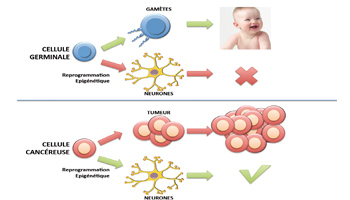07.04.2014
Stem cells and the fight against cancer: a new direction in cellular reprogramming
By simultaneously inhibiting two molecules, Stéphanie Käser-Pébernard, postdoctoral fellow in the Department of Biology of the University of Fribourg, has succeeded in transforming germ cells, which would normally produce spermatozoa and eggs, into neurons. This approach represents a new direction in the area of cellular reprogramming and could, for example, contribute to curbing the proliferation of cancerous cells.
“The aim of our research is to discover the bar code which defines a cell’s future development. We have now succeeded in identifying one bar of this code”, says Stéphanie Käser-Pébernard delightedly. The experiments, which she conducted under the direction of lecturer Chantal Wicky and Professor Fritz Müller of the Zoology Unit at the University of Fribourg, show for the first time that epigenetic phenomena can alone influence the fate of a cell. Up till now, it was thought that they were necessary but not sufficient and that direct action on the genetic code was essential in determining a cell’s development into a germ cell or neuron.

Anklicken zum Vergrössern
Gamete, muscular cell or neuron?
Caenorabditis elegans, an hermaphrodite worm one millimetre in length which develops very rapidly is an excellent model for studying cell fate processes, not only because it is transparent, but also because, right from the first division of the embryo, it is possible to foresee what each of its cells will become. ”We have used this worm to study the effect of certain proteins, or epigenetic factors, on chromatin, the famous ‘pearl necklace’ composed of DNA and all its associated proteins. This has enabled us to establish that the simultaneous inhibition of the proteins LET-418 and SPR-5 (also called LSD1 in mammals) abnormally modifies the histones, those proteins associating with DNA to form chromatin, and that this modification brings about a change of state in the germ cells. Instead of producing gametes, the germ cells become somatic cells of various kinds (muscles, skin, etc.), but mainly neurons. This shows that the LET-418 and SPR-5 proteins do act as a barrier maintaining the gametes in their role. If the barrier falls, there is then nothing to prevent the cells from differentiating. Consequently it is the worm’s whole germline that is transformed. It continues to live, but becomes sterile”, Stéphanie Käser-Pébernard explains.
In therapeutic terms, targeting this modification would allow the development of certain cells to be manipulated. It would, for example, be possible to stop a cancerous cell from dividing by diverting it from its normal path to that of differentiation, that is to say, by forcing it to change into a neuron or some other somatic cell type, which would no longer be able to divide. In this way, the proliferation of cancer cells could be halted. Similar procedures could be developed in the area of tissue regeneration, for example, in order to replace failing organs.
The results of this research have been published in the scientific journal Stem Cell Reports
http://dx.doi.org/10.1016/j.stemcr.2014.02.007
Contact:
Stéphanie Käser-Pébernard, Zoology Unit, stephanie.kaeser-pebernard@unifr.ch, 026 300 88 99